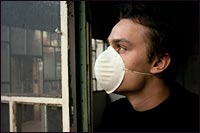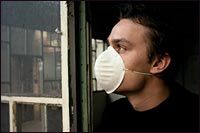Consider the trappings of modern life: Calvin Klein Eternity, gasoline, Gore-Tex, Aveda hairspray, paint, particle board, polyurethane iPod cases.

Is this the face of the future?
Photo: iStockphoto.
Now imagine that you’re allergic to virtually all of them.
Environmentalists usually think about chemical toxicity as either a dramatic local crisis (Bhopal, Love Canal) or the simmering concern of those far away (breast-feeding mothers in the Arctic) or far in the future (our oft-evoked grandchildren). But for people suffering from Multiple Chemical Sensitivities, the chemical crisis is already here. Indeed, thanks to industrialization, it is already everywhere. And, like so many environment-related health issues, it disproportionately affects the poor — and, moreover, drives many once financially stable people into poverty.
As a disease, Multiple Chemical Sensitivities doesn’t have an official case definition yet (more on this soon), but rather refers to a broad range of adverse symptoms brought on by an even more broad array of everyday chemicals. These symptoms are often provoked at exposure levels far below those that seem to affect the rest of the population — levels virtually always present in our homes, workplaces, and social venues. They commonly include severe headaches, food intolerances, difficulty breathing, nausea, irritation of the eyes, ears, nose, throat, and skin, and disorientation or confusion, but there are many more.
The best information currently available suggests that MCS is a chronic condition with no cure. Although some treatments (such as acupuncture) seem to help some patients, recent surveys by the Chemical Injury Information Network, a nonprofit education and advocacy organization for people with chemical sensitivities, found that avoidance of problem chemicals was the only consistently effective treatment.
If only avoidance were as simple as it sounds. Just as modern life almost inevitably involves contributing greenhouse gases to the heating atmosphere, it is all but impossible to navigate the industrialized world without being immersed in tens of thousands of potentially troublesome human-made chemicals. And just as an honest fight against global warming would pose a huge threat to powerful energy companies, a real effort to take MCS seriously could throw a wrench into the operations of a huge range of industries that produce chemicals and chemical-laden products.
Research and You May Not Find
Mainstream medicine has been slow to recognize the role environment can play in disease. With many doctors either unaware of MCS or doubtful it’s a real condition, simply getting diagnosed is a battle. Even those who recognize the disease are often unfamiliar with treatment options. As a result, MCS patients frequently must visit multiple health-care practitioners — a process that is both emotionally and financially costly — before they can put a name to their illness and make the necessary (and often radical and pricey) lifestyle adaptations it requires.
“Prior to 1988, I was a healthy, athletic physician who played drums in a rock band. A year later, I was severely disabled with Multiple Chemical Sensitivities,” wrote Ann McCampbell, a member of the board of the Multiple Chemical Sensitivities Foundation and chair of the MCS Task Force of New Mexico, in Focus magazine. “The onset was subtle, with slowly worsening food intolerances, progressing to the point I could only eat three green vegetables. By then I was also having severe reactions to inhaled substances and had developed headaches, fatigue, heart palpitations, abdominal pains, and nausea. Like so many others with MCS, I could no longer tolerate where I lived and was forced to live outside in my yard, the car, or a makeshift shelter.”
Despite some improvements since then, “I go to few places outside my home,” she wrote, “in order to avoid exposures to cigarette smoke, pesticides, perfume, vehicle exhaust, cleaning products, and other toxic fumes which make me sicker.”
McCampbell hasn’t discovered what triggered her sensitivities, and her baffling experience is typical of many others with MCS. The few scientists studying the disease are baffled as well, struggling to understand its etiology. Current theories range from a genetic predisposition to chemical injury, to neurological damage, to abnormalities in detoxifying enzymes, to a so-called “toxicant-induced loss of tolerance” to environmental stressors, in which one particular exposure to a toxic substance overwhelms a person’s system and leaves them unable to cope with exposures to a wide range of other toxins.
In fact, doctors have thus far failed to agree on a case definition for the disease. That’s created a catch-22: the lack of a definition makes it more difficult to secure funding for MCS research, but more research is needed to better understand and define (not to mention treat and cure) the disease. “Right now, one of the things MCS [researchers and patients] get hammered on is that there is no agreed-upon case definition, despite the fact that three attempts have been made to get the [Centers for Disease Control and Prevention] to accept one,” said Cynthia Wilson, executive director of the Chemical Injury Information Network.
Other activists, like McCampbell, stress that there’s a working definition of MCS, and that the lack of a standardized case definition shouldn’t be used as an excuse to halt research or deny patients crucial accommodations.
What few surveys have been conducted on the prevalence of the disease in the U.S. paint a patchy picture, but hint that it may be relatively widespread. A 1995 survey by the California Department of Health Services found that 6 percent of state residents reported doctor-diagnosed MCS, while a more recent survey of Atlanta, Ga., area residents published in the May 2004 issue of the American Journal of Public Health found that 3 percent of respondents reported receiving an MCS diagnosis.
Home Is Where the Health Is
If those figures are at all representative of the nation as a whole, the number of MCS sufferers could range from 9 million to 17 million. Some of them are undoubtedly able to function with lifestyle adaptations: removing carpet from their homes, filtering air and water, using ultra-eco-friendly cleansers and personal-care products, eating organic foods, and limiting contact with toxic substances like pesticides and solvents. Other patients, however, are far more deeply compromised by the disease.
For those in the latter group especially, the No. 1 issue is housing. “Because of the nature of construction materials, it’s very difficult for people [with MCS] to find safe housing,” says CIIN’s Wilson. And without safe refuge, it is all but impossible to live a relatively symptom-free life.
Some people with severe MCS try to build or renovate from the ground up, using exclusively nontoxic materials, but even under the best financial circumstances this is no small feat. Moreover, people can only exercise so much control over their surroundings — there are neighbors and property owners to worry about. “Even if [people with MCS] find safe housing,” says Wilson, “it doesn’t mean it stays safe housing. If, for example, a bug shows up, a landlord typically wants to spray a pesticide, [rendering] the housing no good for someone with MCS.”
For many without a significant financial safety net, the quest for a safe space is maddening — and the first step on the road to economic ruin. Susan Abod is a Santa Fe, N.M.-based vocal artist and filmmaker with MCS whose latest film, Homesick, documents how people with MCS are affected by their search for safe housing. The ability to cope with the disease, she says, “has to do with access to finances and resources. … If you do have money, you can always find another home, and you can refurbish it with safe products. But those of us who don’t have access to a lot of money or who are renters or who have assisted housing from the government [face] a lot more limits.”

Extreme Makeover: Home Edition.
Photo: iStockphoto.
CIIN’s Wilson concurs. “For lower-income people who do not have the wherewithal to move or to find safe housing, it is a big problem,” she says. “Most people with MCS end up living in their cars.” Others wind up in a friend’s backyard, a stripped-down RV, or a canvas tent on public land. For that reason, the housing problem gets worse in winter, says Wilson, “because people can’t just go camping, can’t solve their problems by living outdoors.”
Nor can they take advantage of traditional safety nets for the homeless. People with MCS “have to stay away from most chemicals that are on people’s clothes, on people’s bodies, and in buildings,” says Rhonda Zwillinger, an artist and photographer who spent close to a decade interviewing and photographing some 250 people with MCS for The Dispossessed Project, a powerful ongoing photo essay. (That project was compiled into a book called The Dispossessed: Living With Multiple Chemical Sensitivities.)
“[The MCS homeless] are mostly not living in urban areas, they’re mostly trying to live in rural areas where the air is cleaner and the water is cleaner, and that becomes a problem because the services [for the homeless] are less available in rural areas,” says Zwillinger. “And they can’t go into shelters the way the [non-MCS] homeless can,” because in a busy building they would likely encounter any number of chemicals their bodies can’t handle.
It can be even more difficult finding an MCS-safe job. Even if a workplace itself is a tolerable environment (rare, given the ubiquity of toxic building materials), basic job-related interactions with the general public can be impossible. “The way a typical story goes,” says Zwillinger, “is that people lose the ability to make a living because they can’t be out in the public arena” without getting ill. Some MCS patients find a way to work from home (assuming they’ve found safe housing) — but that option is seldom available to poorer Americans forced to rely on low-wage, low-skill jobs.
“Almost all of us have to make severe accommodations to [MCS], and it does take a lot of money to successfully do that with any kind of grace,” said Wilson. “Most people find themselves one day employed and the next day unemployable. The financial upheaval that this illness causes is heartbreaking.”
I Know Why the Caged Bird Stopped Singing
Even chemical companies no longer deny that chemicals accumulate in our bodies simply by virtue of being alive today. But they insist that the concentrations are too low to cause any harm. For MCS sufferers, at least, that reassurance rings brutally hollow.
A well-publicized 2003 study by the Environmental Working Group and Mount Sinai Hospital in New York found “an average of 91 industrial compounds, pollutants, and other chemicals in the blood and urine of nine volunteers.” Out of the 210 substances tested for, 167 showed up in at least one of the volunteers. Meanwhile, the Centers for Disease Control and Prevention’s latest National Report on Human Exposure to Environmental Chemicals contains a detailed breakdown of 148 different chemicals and substances found in a representative sample of the U.S. population — from organochlorine pesticides to dioxins to metals like cadmium.
Very little is known about how individual chemicals affect the human body, let alone the potential cumulative effects of dozens or hundreds of interacting chemicals. There are over 80,000 chemicals registered for use in the United States, with up to 2,500 new ones reviewed by the U.S. EPA every year, and government oversight is minimal when there’s any at all. Manufacturers are responsible for safety-testing their own products, and they have no incentive to look for potential problems — quite the contrary.
The lack of chemical regulation in the U.S. is perhaps most glaring in the case of cosmetics and personal-care products, which, given their ubiquity, are subject to shockingly lax oversight. The Food and Drug Administration has nominal authority over them, but little actual regulatory power. Makers of lotions and potions aren’t required to file information on ingredients with the government, or report cosmetic-related injuries. The FDA can’t mandate safety studies of cosmetics, and doesn’t even have the power to order product recalls.
“An average adult is exposed to over 100 unique chemicals in personal-care products every day,” says Jane Houlihan, vice president for research at the Environmental Working Group. “These exposures add up.” EWG has been sounding the alarm on carcinogenic or otherwise worrisome cosmetic ingredients, and has built an interactive database that ranks shampoos, deodorants, and other products on their potential harmfulness.
The ubiquity of cosmetics is just one reason people with MCS remain segregated from society, though there have been some advancements on this front in recent years. Some workplaces and schools (like The Evergreen State College in Olympia, Wash.) have instituted no-fragrance policies — but in general, those with MCS cannot count on much help or protection from employers, landlords, the government, or the medical establishment.
It’s a bitter irony, since many with MCS see themselves as canaries in the modern-day coal mine. As recently as 1986, the exquisitely sensitive yellow birds were used to detect the presence of dangerous gases in mine shafts, and when they showed signs of illness — when they ceased to sing — it was an unambiguous warning: evacuate.
As growing numbers of MCS sufferers are driven from their homes and jobs, pushed to the fringes of medical science and the brink of financial ruin, made sick by industrialized civilization itself, we would do well to heed their equally urgent warning. And fast, because this time around we can’t evacuate. There’s nowhere else to go.



